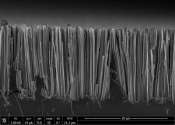Researchers 'iron out' graphene's wrinkles
From an electron's point of view, graphene must be a hair-raising thrill ride. For years, scientists have observed that electrons can blitz through graphene at velocities approaching the speed of light, far faster than they ...








